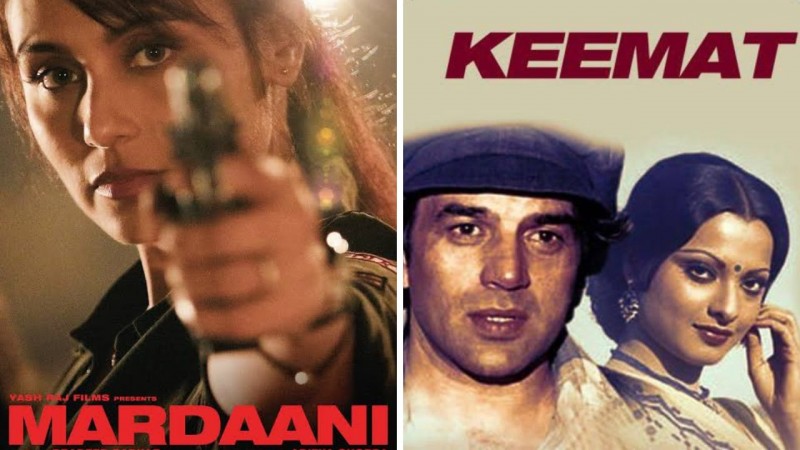
Inspiration is frequently drawn from a variety of sources in the world of Indian cinema, including actual incidents, written works, and even other movies. One such example of cinematic inspiration is the 2014 Indian crime thriller "Mardaani," which drew inspiration in part from the classic Bollywood picture "Keemat" from 1973. Although law enforcement officers fighting crime is a common theme in both movies, they approach the subject matter differently, reflecting the development of Indian cinema over time. To show how "Mardaani" pays homage to its predecessor while forging its own distinctive path, we will examine the similarities and differences between these two movies in this article.
The movie "Keemat," which was directed by Ravi Tandon, was significant at the time. The film, which starred Dharmendra and Rekha as its main actors, examined the dynamics of the criminal underworld and the heroic efforts of law enforcement to tame it. When it was first released in the early 1970s, "Keemat" was a product of its time, replete with action scenes, dramatic dialogue, and a potent fusion of romance and crime. The movie attracted attention for its standout performances and added to the illustrious history of Indian cinema.
Ajay and Vijay, two brave and honorable brothers who work as dedicated police officers, are the focus of the plot of "Keemat" (played by Dharmendra). The movie takes viewers on a wild ride through the crime-ridden streets of Bombay (now Mumbai). The brothers are up against the city's underworld's most powerful and crafty gangster, "King" (prem Chopra), who commands the underworld.
The struggle of the police officers to bring King and his criminal organization to justice is depicted in the movie. With suspenseful action scenes and deeply felt dialogue, "Keemat" explores the central conflict between law and lawlessness, a recurrent theme in Indian cinema. A complete cinematic experience is provided to the audience by the movie's inclusion of elements of family drama, loyalty, and sacrifice.
"Keemat" created a precedent for subsequent crime dramas and left a lasting impression on the Indian film industry. Its portrayal of tough police officers, thrilling action sequences, and memorable dialogue served as a model for other movies in the same genre. Dharmendra's status as a top actor in the business was further cemented by the movie's success.
In the four decades following the release of "Keemat," there were significant changes in Indian cinema, both in terms of the narrative and the portrayal of women in leading roles. Rani Mukerji and Pradeep Sarkar's "Mardaani," one of the most notable examples of this development. In homage to "Keemat," the movie offered a contemporary interpretation of the crime thriller subgenre.
Shivani Shivaji Roy, a fearless and devoted Senior Inspector of the Mumbai Crime Branch, is the subject of the compelling narrative in "Mardaani" (played by Rani Mukerji). The film delves into the terrifying world of child trafficking, a serious issue that wasn't as prominently covered in "Keemat." Shivani starts a relentless pursuit to bring down Karan Rastogi, the mastermind of a child trafficking ring (played by Tahir Raj Bhasin).
In "Mardaani," the main character challenges social norms by assuming the role of a strong, independent woman in a field that is predominately male. This is just one example of how she goes beyond simply maintaining law and order. The movie emphasizes the value of gender equality and women's empowerment, which resonates with current social issues.
While "Keemat" primarily focused on the male protagonists taking on a crime lord, "Mardaani" puts a strong female character in the lead, signifying the shifting dynamics of gender representation in Indian cinema.
"Mardaani" made history by addressing the crucial issue of child trafficking in India and bringing attention to the heinous crimes committed against defenseless children. The film's fearless and unapologetic portrayal of the problem sparked discussions and awareness about child exploitation, further highlighting the effectiveness of cinema as a tool for social change.
The movie "Mardaani" also demonstrates Rani Mukerji's range as an actor. She received praise from critics for her portrayal of Shivani Shivaji Roy, which made her a standout female lead in Bollywood and was praised for its depth and authenticity.
The legacy of classic films like "Keemat" (1973) continues to have an impact on more recent works like "Mardaani" (2014) in the Indian film industry. With its action-packed plot and potent male leads, "Keemat" established the blueprint for Bollywood's crime thrillers. However, "Mardaani" modernized the genre by focusing on a strong female protagonist and tackling important social issues.
Both movies offer different perspectives on law enforcement and crime, and they are both reflections of their eras. Although "Mardaani" embraces contemporary themes and a more inclusive representation of gender, it also serves as a testament to how Indian cinema is evolving. "Keemat" is still regarded as a beloved classic.
It is clear that India's cinematic landscape has advanced significantly in terms of storytelling, character portrayal, and its capacity to address challenging social issues as audiences continue to enjoy and value both movies. By acknowledging "Keemat's" influence and elevating the genre, "Mardaani" pays homage to it and demonstrates the enduring ability of Indian cinema to move viewers and spark discussion.
Yash Chopra's 'Jab Tak Hai Jaan' Takes Its Bow